Some decades back, the late John Dean “Jeff” Cooper came up with a concept for what he ultimately called a “scout rifle.” This was intended to be an all-around rifle, capable of being used for hunting, but especially useful for the lone military scout (an ancient term). The precise details of this light bolt-action rifle concept have been listed here and there over the years. Some of the specs included 308 caliber, minimal length and weight, a forward-mounted scope, possible provisions for clip loading, a suitable sling, and numerous other features that had great value to the late Mr. Cooper and his fans. After years of searching for the best solution, and the construction of several custom rifles that came close to Cooper’s ideal, along came Steyr, which incorporated most of Cooper’s rifle ideas into the Steyr Scout, which actually had Jeff Cooper’s personal monogram on it. The Steyr Scout rifle so pleased Mr. Cooper that, so far as we know, he ceased his efforts to find a better version of his concept. But that did nothing to stop other makers from coming up with rifles that vaguely approximated some of the scout-rifle features, and of course these had the “scout” name attached to them.
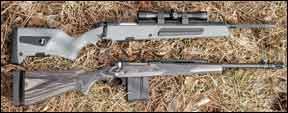
Ruger has offered several short 308 rifles, including one a few years ago that also had provisions for a forward-mounted scope. The Frontier rifle was heavy and generally had none of the better features of the Steyr. Savage also has a scout rifle, and we have a test scheduled on one of those in the near future. But now Ruger has again come out with a scout rifle that looks a lot more like it. It even bears the name of the rifle range that Jeff Cooper began—Gunsite—in Arizona. The new Ruger is called the Gunsite Scout.
We thought it would be interesting to compare the new Ruger Gunsite Scout (MSRP $995) with the established and still available Steyr Mannlicher Scout rifle (MSRP $2975 in the limited-edition Jeff Cooper Commemorative package). We checked pricing on AuctionArms.com and found no listings for the new Gunsite rifle. One seller, Northwest Armory in Portland, had two Steyr Scouts in 308 Win. listed with a buy-it-now-price of $1881.
One of our staff loaned us his original Steyr JC Scout for this test. We shot the two rifles with a mixed batch of recovered military ball ammo, with Winchester Match, Hirtenberger 150-grain JSN, and with a handload featuring a 150-grain soft-nose bullet. Here’s what we found.
Ruger Gunsite Scout M77-GS Model 6803
308 Win., $995
The Ruger was an attractive, business-like rifle. Its dark laminated stock, stepped barrel, clean checkering, and iron sights gave it a near-military look. We were quite surprised to find a genuine flash hider on the front end of the Ruger Scout. We liked the aperture rear sight and wing-protected, flat-top post front, which gave an excellent sight picture. The aperture was adjustable for both windage and elevation. We did not shoot the rifle with the iron sights.
Before we mounted our Leupold Scout test scope we took a series of wrenches to the new Ruger to verify all the screws were tight, and we’re glad we did. All the screws, including the action screws, the cross bolts in the stock to prevent splitting, the rear-sight mounting screw, and the four screws that attach the forward-reaching Picatinny rail to the Ruger were loose. This is not the way to send a rifle out to a prospective customer, we thought. If a buyer mounted a scope without checking the screws, the result would almost certainly be very poor accuracy, plus battering and potential damage to the stock and scope mounts.
The next thing we discovered was the scope rings that Ruger proudly sends out with each of its rifles were absolutely no good for mounting the Scout scope on this Scout rifle. If you want to negate all the advantages of the forward-mounted scope, you could use the Ruger rings and mount a scope normally. We doubt anyone who knows what this rifle is about would choose to do that. We used our trusted Weaver bases to attach the Leupold 2.5x scope.
With the scope mounted and everything tight, the next things we
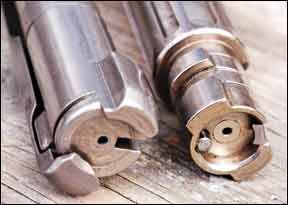
noticed were the profusion of extremely sharp metal edges within the ejection port. The rails along which the bolt slides had upper edges sharp enough to shave, let alone cut paper. Years ago we complained about this sort of thing and for a time Ruger took good care of their over-sharp edges. Not so on this new Scout rifle. Buyer beware of lacerated fingers. We used a file and scraper to remove the potentially damaging sharp edges inside the action, and advise Ruger to do the same before someone cuts himself badly and chooses to lay blame on the manufacturer.
The Ruger had a stock of laminated wood. This stuff is not known for its lightness. A more suitable material might have been reinforced polymer, which could have resulted in a lighter rifle. Laminated stocks are known for their strength, and that’s mighty important, but reinforced polymer stocks are also very strong. We liked the adjustable-pull-length feature, though we were happy with the length as it came. Several inserts could be added, or one removed, to change the length as desired in half-inch increments. We liked the sharp checkering on the Ruger very much. The recoil pad was relatively soft. The trigger guard was plastic, as was the magazine well.
On the range we found another bone to pick. Loading the magazine was not easy. It required depressing the magazine in front of the retention lips with the incoming round, and then sliding the round rearward. This was fussy and did not get much easier with practice, nor could it be done in a hurry. By contrast, the Steyr’s magazines were extremely easy to load.
On the range, the Ruger settled down after just a few shots and started to shoot quite well, even with the poorest-quality ammo we tried, the mixed batch of recovered military ball. Three-shot groups were under 2 inches at 100 yards. The Ruger’s trigger was very good, which helped our shooting. Our test scope had fine crosshairs, and that also helped. The Steyr’s scope had the coarser, easier-seen crosshairs that we much prefer for field use, but they are not the best for target work. We noted that occasionally some of this mixed ammo gave a tremendous muzzle flash. Even the Ruger’s flash hider could not prevent a huge ball of flame out front, though it was less than the fireball from the Steyr’s muzzle. At any rate, accuracy with the Ruger was on a par with that from the Scout, which was very good.
The feeding from the magazine was rough. It required a strong push on the bolt to move the rounds out of the magazine. The bolt was smooth enough, although we could get it to bind if we pressed sideways on the bolt knob. It was possible to load rounds singly, but it required careful handling. The Steyr, on the other hand, had a provision for this, which we’ll discuss later. Getting the magazine in and out of the rifle was easy. Ruger provided 5- and 10-round magazines, but no sling.
The Ruger showed many positives, including appearance, accuracy, the flash hider, 10-round magazine, adjustable-pull length, and iron sights. But our testers disliked its rough feeding, though we
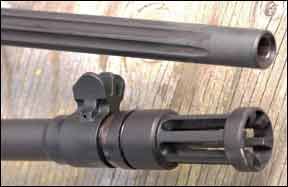
noted the bolt movement got distinctly easier during our limited testing. They also disliked the hard-to-load magazines and the lack of rings to mount a scope. The Steyr comes with a scope and a sling, both top-notch quality. Those items would add significantly to the cost of the Ruger, with the result that the as-tested Steyr is about twice the cost of the Ruger, not three times. We think the Ruger could be slicked up significantly with a bit of work and dedication by the owner, and of course many buyers will opt for the lower-priced Ruger Scout over the Steyr. But the Ruger doesn’t need to be anywhere near this heavy. The empty Ruger weighs as much as the Steyr, fully loaded with 10 rounds in two magazines and heavy Ching sling. And the Ruger doesn’t have a bipod.
Our Team Said: In short, we think the Ruger is the second-best Scout rifle we’ve examined. It has a lot of potential, but because of its slight problems, rough feeding, sharp edges, and excessive weight, we gave the Ruger a grade of B-. Those who think the new Ruger is a close approximation of the Steyr Scout are kidding themselves.
Steyr Jeff Cooper Scout 308 Winchester, $2975
The price given is for the Commemorative Edition Jeff Cooper Package Steyr Scout rifle, released in June 2010, of which there are going to be 300 made, all in caliber 308. However, the “Mannlicher Scout,” as it is now called, is available in other finishes with all the features of the Jeff Cooper version except for his monogram and the gray stock, and with a few other options left off such as the scope and sling. The Mannlicher Scout is available in 223, 243, 7mm-08, and 308. It has either a set trigger or a normal one, comes in black, camo, or “timber” finishes, and lists for $2100 in black stock without scope or sling. Our test rifle is one of the original-issue Jeff Cooper Scout rifles, previously called the Steyr Scout, Jeff Cooper package. The Commemorative version appears to be identical to the original setup.
The various Steyr packages are available with or without scopes. The one closest to the Ruger is a black-stock version without scope for $2100. Add $100 for a camo stock, and $600 for the scoped package. With the new Cooper package you get a soft case, hard case, scope, Ching sling, and one of Cooper’s books. We don’t know what all you get with the non-Cooper scoped packages, nor could we find out from the Steyr website (www.steyrarms.com). The scoped non-Cooper Steyr Mannlicher Scouts list for $2700.
At any rate there are no shortages of Scout variants from Steyr. The company website still lists the 376 Scout, rumored to have been dropped from production, if anyone is interested. But it’s not listed on the price sheet. There are numerous discrepancies between the price list and the on-screen prices, so buyer be aware. The Steyr Scout has 1:10-inch twist with four grooves, while the Ruger has the same twist with six grooves. What you get for your money is a light rifle with two magazines (either five or 10 rounds each), an integral bipod, flip-up aperture sights, an adjustable trigger, and the Steyr safe-bolt system, which permits complete locking of the bolt, and also the advantage of a silent safety in the best possible position, right on top of the wrist.
The slim barrel of the Steyr is grooved to cut weight. The stock is reinforced polymer, as are the magazines. Our test rifle had five-round mags, but the 10-round versions are still available in 308 and 7mm-08 calibers. We really liked the Ching sling, which permits easy carry plus the ability to get into a shooting-sling position very quickly. It does add significant weight (7.6 ounces), being of heavy leather and having an extra length of stock for the shooting-sling setup. There is also a forward rail, for those who need or want one, between the bipod legs and under the forend. The rifle is beautifully balanced, especially when fully loaded with two five-round mags. The accuracy is there, but not easy to prove
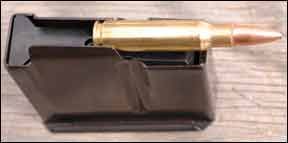
with the heavy-reticle scope attached. The owner put on a 36x target scope to verify the rifle, and shot many sub-inch groups at 100 yards with match ammo. With hunting ammo and the proper scope attached, as we proved, the accuracy was 1.2 to 1.5 inches, depending on type of ammo used, at least on a par with the Ruger. We used our machine rest to test both rifles, and did not use the Steyr’s bipod.
There is another feature we like very much about the Steyr Scout. The magazines have two positions, fully seated and not-quite seated. The double detents permit leaving the magazine securely attached, but not in line with the bolt. The shooter can thus shoot one and load one, with the fully loaded magazine remaining in position in reserve. The Ruger system does not attempt this.
The Steyr’s buttpad is hard, but does offer some protection and a non-slip surface. Frankly, we didn’t notice any significant recoil from either rifle. But there’s more. The hand-removable pad conceals a trap in the stock for whatever you might want to store there. And of course there are inserts to alter the pull length, a feature copied by Ruger. The Steyr’s trigger is adjustable from the outside.
The bolt is unique. In short, it can be locked in a position that has the handle lowered against the stock. From this position the rifle cannot be fired, nor the bolt moved. To unlock the bolt, the safety button must be depressed and the safety rolled forward, which reveals a white dot and simultaneously springs the bolt handle back to its normal position. To fire the rifle, roll the safety still farther forward to reveal a red dot. To remove the bolt, lift its handle and then roll the safety backward to the button-up locking position, and then pull the bolt out.
As for smoothness of operation, the ancient Mannlicher Schnauer rifles had legendary slippery bolts. The Steyr Scout is in the same league with them. This is one slick bolt, and feeding is very smooth and positive from the magazine. The bolt head is not controlled feed, however, and the owner has to be aware of that. If you shove a round loosely into the rifle and fail to lock the bolt over it so the extractor can snap into place, it’s possible to feed a second round against the back of the round already in there, creating a jam.
On the range the Steyr proved to be as accurate as the Ruger, perhaps a bit better with better ammo, and maybe not quite as accurate with poor ammo. There were no problems of any sort. The trigger pull was crisp and light, and we believe our accuracy attempts were somewhat hampered by the thick crosshairs on the scope.
Our Team Said: We very much liked the Steyr and all its features. We gave the rifle a grade of A. We liked the possibility of using the shooting sling, but would much prefer a lighter version of the Ching sling. You can save money over the Steyr packages by installing your own sling and scope (Steyr charges $250 to sight-in the rifle if you have them do it), so you needn’t spend the full amount, unless you must have the Cooper package. Is the cost of the Steyr Scout justified? We thought so, inasmuch as you can’t get a better Scout rifle anywhere for any less money. Jeff Cooper thought so, too.

























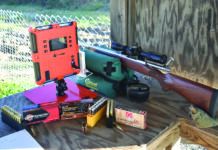

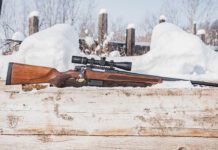

This article is clearly biased towards the Steyr long before the Ruger came out. Perhaps you could find some objective journalists?
As a counter to California’s anti-AR aggressiveness , I purchased a Ruger Gunsite Scout Rifle. I have had it out to the range twice using the Vortex Scout Scope. I must say I am highly impressed with my rifle (I also own an M1A & SOCOM). It is my first bolt action and I took great care in reading the instruction manual, doing a cursory cleaning, lubrication, and manipulation of the controls.
I was getting a feel for the rifle as well as sighting it in. So far I have no regrets about this purchase and my gun junkie friends love it as well.
They failed to mention that the Steyr is one butt ugly rifle! Also, it’s thin profile barrel heats up faster than the GSR and groups will open up sooner. Bipod is flimsy and barrel is not threaded. Iron sights are more robust on the Ruger.